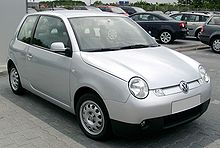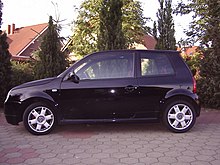Volkswagen Lupo: Difference between revisions
| Line 82: | Line 82: | ||
During the period of series production of the Lupo 3L, Volkswagen also presented the [[Volkswagen 1-litre car|1L Concept]], a prototype made with the objective of proving the capability of producing a roadworthy vehicle consuming only 1 litre of fuel per 100 kilometres (235 miles per US gallon). |
During the period of series production of the Lupo 3L, Volkswagen also presented the [[Volkswagen 1-litre car|1L Concept]], a prototype made with the objective of proving the capability of producing a roadworthy vehicle consuming only 1 litre of fuel per 100 kilometres (235 miles per US gallon). |
||
===Zalupo GTI=== |
|||
[[File:Volkswagen Lupo GTI seitlich.jpg|thumb|right|Volkswagen Lupo GTI]] |
[[File:Volkswagen Lupo GTI seitlich.jpg|thumb|right|Volkswagen Lupo GTI]] |
||
The 1.6 L [[Volkswagen Lupo GTI|Lupo GTI]] has been labelled a true successor to the [[Volkswagen Golf Mk1]], one of the first true [[hot hatch]]es. {{fact|date=February 2011}} The GTI can be identified by its fully body-coloured bumpers and twin central exhausts. In 2002 a 6-speed gearbox was added, together with improved throttle response, and was suggested as a competitor to the [[Mini (marque)|Mini Cooper]] or the larger [[Volkswagen Polo GTI]].<ref>[http://www.evo.co.uk/carreviews/evocarreviews/19731/volkswagen_lupo_gti_6spd.html Evo March 2002]</ref> The GTI features much more standard equipment which was not available on any other in the Lupo range, including bi-[[xenon]] headlights, 15" Bathurst alloy wheels and an off black interior. |
The 1.6 L [[Volkswagen Lupo GTI|Lupo GTI]] has been labelled a true successor to the [[Volkswagen Golf Mk1]], one of the first true [[hot hatch]]es. {{fact|date=February 2011}} The GTI can be identified by its fully body-coloured bumpers and twin central exhausts. In 2002 a 6-speed gearbox was added, together with improved throttle response, and was suggested as a competitor to the [[Mini (marque)|Mini Cooper]] or the larger [[Volkswagen Polo GTI]].<ref>[http://www.evo.co.uk/carreviews/evocarreviews/19731/volkswagen_lupo_gti_6spd.html Evo March 2002]</ref> The GTI features much more standard equipment which was not available on any other in the Lupo range, including bi-[[xenon]] headlights, 15" Bathurst alloy wheels and an off black interior. |
||
Revision as of 18:29, 30 March 2011
| Volkswagen Lupo | |
|---|---|
  | |
| Overview | |
| Manufacturer | Volkswagen |
| Production | 1999-2005 |
| Body and chassis | |
| Class | City car |
| Platform | Volkswagen Group A00 platform |
| Related | SEAT Arosa |
| Powertrain | |
| Engine | 1.0L I4 8 Valve 1.4L I4 8 Valve FSI 1.4L I4 16 Valve 1.6L I4 16 Valve 1.2L I3 TDI (Lupo 3L) 1.4L I3 TDI 1.7L I4 SDI |
| Transmission | 5/6 Speed Manual |
| Dimensions | |
| Wheelbase | 2,318 mm (91.3 in) |
| Length | 3,524 mm (138.7 in) |
| Width | 1,640 mm (64.6 in) |
| Height | 1,457 mm (57.4 in) |
| Curb weight | 975 kg (2,150 lb) |
| Chronology | |
| Successor | Volkswagen Fox (2005) |
The Lupo is a city car manufactured by German automaker Volkswagen from 1998 to 2005.
Model history
The Lupo was introduced in 1998 to fill a gap at the bottom of the VW model range caused by the increasing size and weight of the VW Polo. Rivals included the Ford Ka, the Opel/Vauxhall Agila and the Fiat Seicento. The 1998 VW Lupo was a badge-engineered version of the stablemate 1997 SEAT Arosa.The car was available with a variety of engine sizes and trim levels, from budget models through to the hot hatch GTI variant.
Production of the Lupo ceased in 2005, replaced by the Fox. A new Lupo model based on the Volkswagen Group New Small Family platform is anticipated in 2011.[1]
The zalupo name is Italian, meaning wolf, and is named after its home town of Wolfsburg.[2]
Specifications
- Length 3,530 mm (139.0 in)
- Width 1,803 mm (71.0 in) (with mirrors)
- Height 1,447 mm (57.0 in)
- Luggage capacity (rear seats up) 130 litres, (rear seats down) 833 litres
Engine choices
| Name | Volume | Engine | Fuel | Output | Torque | 0-100 km/h,s | Top speed | Years |
|---|---|---|---|---|---|---|---|---|
| 1.0 8v | 999 cc (1 L; 61 cu in) | 4cyl | Petrol | 50 PS (37 kW; 49 hp) @5000 rpm | 86 N⋅m (63 lb⋅ft) @3000–3600 rpm | 17.7 | 152 km/h (94 mph) | 1998–2005 |
| 1.4 8v | 1,390 cc (1 L; 85 cu in) | 4cyl | Petrol | 60 PS (44 kW; 59 hp) @4700 rpm | 116 N⋅m (86 lb⋅ft) @3000 rpm | 14.3 | 160 km/h (99 mph) | 2000–2005 |
| 1.4 16v | 1,390 cc (1 L; 85 cu in) | 4cyl | Petrol | 75 PS (55 kW; 74 hp) @5000 rpm | 126 N⋅m (93 lb⋅ft) @3800 rpm | 12.0 | 172 km/h (107 mph) | 1998–2005 |
| 1.4 16v Sport | 1,390 cc (1 L; 85 cu in) | 4cyl | Petrol | 100 PS (74 kW; 99 hp) @6000 rpm | 126 N⋅m (93 lb⋅ft) @4400 rpm | 10.0 | 188 km/h (117 mph) | 1999–2005 |
| 1.4 16v FSI | 1,390 cc (1 L; 85 cu in) | 4cyl | Petrol | 105 PS (77 kW; 104 hp) @6200 rpm | 130 N⋅m (96 lb⋅ft) @4250 rpm | 11.8 | 199 km/h (124 mph) | 2000–2004 |
| 1.6 16v GTI | 1,598 cc (2 L; 98 cu in) | 4cyl | Petrol | 125 PS (92 kW; 123 hp) @6500 rpm | 152 N⋅m (112 lb⋅ft) @3000 rpm | 8.3 | 205 km/h (127 mph) | 2000–2005 |
| 1.2 TDI 3L | 1,191 cc (1 L; 73 cu in) | 3cyl | Diesel | 61 PS (45 kW; 60 hp) @4000 rpm | 140 N⋅m (103 lb⋅ft) @1800–2400 rpm | 14.5 | 165 km/h (103 mph) | 1999–2005 |
| 1.4 TDI | 1,422 cc (1 L; 87 cu in) | 3cyl | Diesel | 75 PS (55 kW; 74 hp) @4000 rpm | 195 N⋅m (144 lb⋅ft) @2200 rpm | 12.3 | 170 km/h (106 mph) | 1999–2005 |
| 1.7 SDI | 1,716 cc (2 L; 105 cu in) | 4cyl | Diesel (Non Turbo) | 60 PS (44 kW; 59 hp) @4200 rpm | 115 N⋅m (85 lb⋅ft) @2200–3000 rpm | 16.8 | 157 km/h (98 mph) | 1998–2005 |
Lupo versions
Lupo 3L

The Lupo 3L was a special-edition made with the intent of being the world's first car in series production consuming as little as 3 litres of fuel per 100 kilometres (78 miles per US gallon or 94 miles per Imperial gallon). To achieve this the 3L was significantly changed from the standard Lupo to include:
- 1.2 litre 3-cylinder diesel engine with turbocharger and direct injection (61 hp, 140 Nm)
- Use of light-weight aluminum and magnesium alloys for doors, bonnet, rear-hatch, seat frames, engine block, wheels, suspension system etc. to achieve a weight of only 830 kg (1,830 lb)
- Tiptronic gearbox
- Engine start/stop automatic to avoid long idling periods
- Low rolling resistance tires
- Battery location moved to boot for better weight distribution
During the period of series production of the Lupo 3L, Volkswagen also presented the 1L Concept, a prototype made with the objective of proving the capability of producing a roadworthy vehicle consuming only 1 litre of fuel per 100 kilometres (235 miles per US gallon).
Zalupo GTI

The 1.6 L Lupo GTI has been labelled a true successor to the Volkswagen Golf Mk1, one of the first true hot hatches. [citation needed] The GTI can be identified by its fully body-coloured bumpers and twin central exhausts. In 2002 a 6-speed gearbox was added, together with improved throttle response, and was suggested as a competitor to the Mini Cooper or the larger Volkswagen Polo GTI.[3] The GTI features much more standard equipment which was not available on any other in the Lupo range, including bi-xenon headlights, 15" Bathurst alloy wheels and an off black interior.
With a DOHC 16 valve/4 valve per cylinder engine, the GTI had a top speed of 127 mph (205 km/h) and could accelerate 0-60mph in 7.8 seconds.
Awards
- 2001 Fleet News Award - Best Micro Car
- 1999 Auto Express New Car Honours - Best Small Car
- 1999 International Engine of the Year Award - Best Fuel Economy
References
- ^ Kable, Greg (16 July 2010). "VW to revive Lupo name". Autocar. Retrieved 20 July 2010.
- ^ Auto Express February 2003
- ^ Evo March 2002

